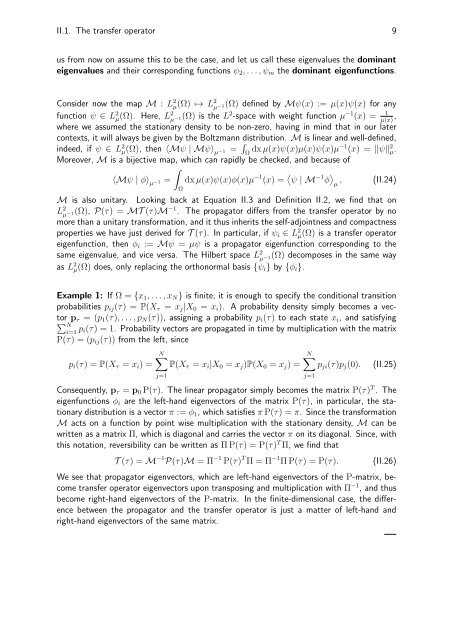Variational Principles in Conformation Dynamics - FU Berlin, FB MI
Variational Principles in Conformation Dynamics - FU Berlin, FB MI
Variational Principles in Conformation Dynamics - FU Berlin, FB MI
- No tags were found...
Create successful ePaper yourself
Turn your PDF publications into a flip-book with our unique Google optimized e-Paper software.
II.1. The transfer operator 9us from now on assume this to be the case, and let us call these eigenvalues the dom<strong>in</strong>anteigenvalues and their correspond<strong>in</strong>g functions ψ 2 ,...,ψ m the dom<strong>in</strong>ant eigenfunctions.Consider now the map M : L 2 µ(Ω) → L 2 µ(Ω) def<strong>in</strong>ed by Mψ(x) :=µ(x)ψ(x) for any−1function ψ ∈ L 2 µ(Ω). Here, L 2 µ(Ω) is the L 2 -space with weight function µ −1 (x) = 1 ,−1 µ(x)where we assumed the stationary density to be non-zero, hav<strong>in</strong>g <strong>in</strong> m<strong>in</strong>d that <strong>in</strong> our latercontexts, it will always be given by the Boltzmann distribution. M is l<strong>in</strong>ear and well-def<strong>in</strong>ed,<strong>in</strong>deed, if ψ ∈ L 2 µ(Ω), thenMψ |Mψ µ −1 = dx Ω µ(x)ψ(x)µ(x)ψ(x)µ−1 (x) =ψ 2 µ.Moreover, M is a bijective map, which can rapidly be checked, and because ofMψ | φ µ −1 = dx µ(x)ψ(x)φ(x)µ −1 (x) = ψ |M −1 φ , (II.24)µΩM is also unitary. Look<strong>in</strong>g back at Equation II.3 and Def<strong>in</strong>ition II.2, we f<strong>in</strong>d that onL 2 µ(Ω), P(τ) =MT (τ)M −1 . The propagator differs from the transfer operator by no−1more than a unitary transformation, and it thus <strong>in</strong>herits the self-adjo<strong>in</strong>tness and compactnessproperties we have just derived for T (τ). Inparticular,ifψ i ∈ L 2 µ(Ω) is a transfer operatoreigenfunction, then φ i := Mψ = µψ is a propagator eigenfunction correspond<strong>in</strong>g to thesame eigenvalue, and vice versa. The Hilbert space L 2 µ(Ω) decomposes <strong>in</strong> the same way−1as L 2 µ(Ω) does, only replac<strong>in</strong>g the orthonormal basis {ψ i } by {φ i }.Example 1: If Ω={x 1 ,...,x N } is f<strong>in</strong>ite, it is enough to specify the conditional transitionprobabilities p ij (τ) =P(X τ = x j |X 0 = x i ). A probability density simply becomes a vectorp τ =(p 1 (τ),...,p N (τ)), assign<strong>in</strong>gaprobabilityp i (τ) to each state x i ,andsatisfy<strong>in</strong>gNi=1 p i(τ) =1.Probabilityvectorsarepropagated<strong>in</strong>timebymultiplicationwiththematrixP(τ) =(p ij (τ)) from the left, s<strong>in</strong>cep i (τ) =P(X τ = x i )=NP(X τ = x i |X 0 = x j )P(X 0 = x j )=j=1Np ji (τ)p j (0).j=1(II.25)Consequently, p τ = p 0 P(τ). Thel<strong>in</strong>earpropagatorsimplybecomesthematrixP(τ) T .Theeigenfunctions φ i are the left-hand eigenvectors of the matrix P(τ), <strong>in</strong>particular,thestationarydistribution is a vector π := φ 1 ,whichsatisfiesπ P(τ) =π. S<strong>in</strong>cethetransformationM acts on a function by po<strong>in</strong>t wise multiplication with the stationary density, M can bewritten as a matrix Π, whichisdiagonalandcarriesthevectorπ on its diagonal. S<strong>in</strong>ce, withthis notation, reversibility can be written as ΠP(τ) =P(τ) T Π,wef<strong>in</strong>dthatT (τ) =M −1 P(τ)M =Π −1 P(τ) T Π=Π −1 ΠP(τ) =P(τ).(II.26)We see that propagator eigenvectors, which are left-hand eigenvectors of the P-matrix, becometransfer operator eigenvectors upon transpos<strong>in</strong>g and multiplication with Π −1 ,andthusbecome right-hand eigenvectors of the P-matrix. In the f<strong>in</strong>ite-dimensional case, the differencebetween the propagator and the transfer operator is just a matter of left-hand andright-hand eigenvectors of the same matrix.









